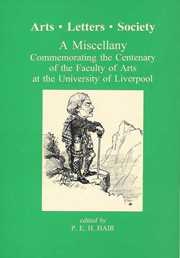 Arts - Letters - Society
Arts - Letters - Society Book contents
- Frontmatter
- Contents
- Introduction
- Preface
- PART 1 I REMEMBER ..
- PART 2 ESSAYS INFORMATIVE AND CRITICAL
- The Claims of the Arts Faculty
- The Buildings of the Faculty of Arts
- How a Redbrick Arts Faculty Worked
- The Humanities in a Technological Age
- The Real Mackay
- The Once and Future Faculty
- APPENDIX
- List of Illustrations
- Index
- Plate section
How a Redbrick Arts Faculty Worked
from PART 2 - ESSAYS INFORMATIVE AND CRITICAL
- Frontmatter
- Contents
- Introduction
- Preface
- PART 1 I REMEMBER ..
- PART 2 ESSAYS INFORMATIVE AND CRITICAL
- The Claims of the Arts Faculty
- The Buildings of the Faculty of Arts
- How a Redbrick Arts Faculty Worked
- The Humanities in a Technological Age
- The Real Mackay
- The Once and Future Faculty
- APPENDIX
- List of Illustrations
- Index
- Plate section
Summary
Like any other institution the Arts Faculty has changed its structure and function over time. I now describe how its formal machinery operated in certain past decades not too long ago - this does not necessarily indicate the more recent operation and it certainly does not provide proof of how the Faculty operated in the previous half century or so. The Faculty is an intermediate structure between the Departments and the University. The latter consists, in power terms, of a Senate of academics notionally controlling as much as possible of what are contemporaneously considered academic affairs, and an administration made up of professional managers, notionally overseen by a Council of outside laity and academics. Between the two is - and always has been - a vast grey area, not least since the administration obtains and administers finance while the Senate attempts to dispense it. A trivial recent example of the grey area will suffice. The University, in the course of moving from a free issue to free purchase of the staff diary, has progressively dropped from its listing of academic members details of individual marital status and gender ascription, and separate listing of professors (and hived off address and telephone number into a separate publication); each step being taken by an administrator - no doubt for what seemed to him (or her) good reasons - without (as far as I can discover) any consultation with the academic staff, via Senate or otherwise.
- Type
- Chapter
- Information
- Arts - Letters - SocietyA Miscellany Commemorating the Centenary of the Faculty of Arts at the University of Liverpool, pp. 161 - 166Publisher: Liverpool University PressPrint publication year: 1996
